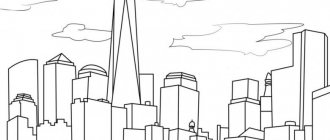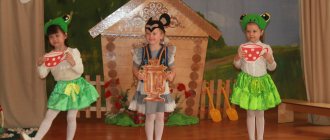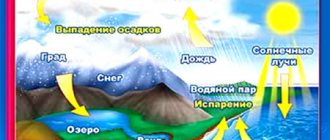GCD for the older group. My city
Abstract of the educational activity “Travel around your hometown” for children of the older group.
Author: Elena Nikolaevna Elchaninova, teacher of MKDOU “Kindergarten No. 6”, Liski, Voronezh region. Topic: “Travel around the hometown” Purpose: To continue to form children’s basic understanding of their small homeland - Liski, based on familiarization with the immediate surroundings and attractions of the city. Objectives: Educational: - to give an idea that for every person, the small Motherland is the place where he was born, where he spent his childhood - to continue to introduce children to the history of our city. To consolidate the names of streets, children's knowledge of the coat of arms and its symbolic meaning. - create a desire to talk about your family’s coat of arms: what your parents’ names are, where they work, what family members’ hobbies are. Developmental:
-develop verbal communication skills, the ability to answer questions with complete answers;
Educational:
- to cultivate patriotic feelings, love for one’s hometown, a culture of verbal communication;
-continue to foster friendly relationships between children. Preliminary work: Conversations about the family: “Me and my family”, “A day off with my parents”. Looking at photographs of the city of Liski; Excursion to the museum"; Application “The house where I live”; Drawing on the theme “My Home”; "My family". Equipment: Puzzles of the Liski coat of arms;
audio recording of the Russian anthem, poem about the Liskis, family coats of arms, computer, easel. Progress of the lesson.
The tables are arranged in a semicircle, puzzles are on two tables, and family coats of arms are on easels.
Educator: Hello, dear guests, colleagues! Guys, look how many guests came to us! Let's wish them good health. And how to do it? That's right, you have to say “Hello.” Educator: And what is our meeting dedicated to, you will find out after listening to these lines: 1 reader What do we call the Motherland? The house where you and I live, And the birch trees along which We walk next to our mother. 2 reader What do we call Motherland? A field with a thin spikelet, Our holidays and songs, A warm evening outside the window. 3 reader What do we call Motherland? Everything that we cherish in our hearts, And under the blue-blue sky is the Land in which we live. Educator: Tell me what is the correct name for the land? Is the land expensive? Is the land golden? - No, it’s better to tell her, dear! After all, there is no better country than ours. Educator: Guys, what are these lines talking about? Children: about the homeland. Educator: What is the Motherland? Homeland means native, this is my country, this is my home, the city in which I live, it is not chosen, it is given to a person from birth. There is a Nice Town in the Voronezh Region. This region is Lisyansky’s native Sweet Corner. Here are forests, native fields, marvelous meadows. There are wide open spaces here - Simply beautiful. Educator: That's right, the conversation will be about our hometown. 1. What is the name of our city and why? (Liski) 2. How old is our city? (77 years old) 3. How can you call the residents of our city in one word? (Liskintsi) 4. What is the name of the street where you live? And you? 5. The river on which our city stands? (Don) Guys, please tell me how Liskinites should treat their hometown? (Take care, keep it clean, do everything to make the city beautiful) Educator: Now we will take you on a short tour of our city, the guides will be Polina, Polina and Dima. (children's stories are accompanied by a slide show). 1 child The city of Liski is located on the Don, 98 kilometers from Voronezh, in the very center of the Voronezh region. Its main feature is that it is a large railway junction. 2nd child The name Liski is associated not with foxes, but with bald ones. “Lyskaya” was a treeless area. 3 child The Liskinsky district is rich in beautiful landscapes, filled with clean air, filled with the aromas of mixed forests, the presence of rivers makes the places in the Liskinsky district favorable for climate therapy. In the vicinity of the city of Liski on the right bank of the Don at the mouth of the Tikhaya Sosna River there is Divnogorye - an amazingly picturesque area with rock monasteries. One of the attractions of Liski is the children's railway. 1 child. Monuments: in Liski there is a monument to railway workers, a monument to the steam locomotive FD-20, a monument to the Great Patriotic War, St. George and other monuments. Educator: Guys, thank you for your stories, they are very informative. The first verse of the Russian anthem is played. All the children stand up and then sit down. Educator: What happened? Why did you get up? (the Lisok anthem was played) What is the anthem? (solemn song) - The anthem is a solemn song designed to unite and inspire the Russian people. It is performed at ceremonial moments and everyone listens while standing. “A walk through the streets of our city” 1. On which street is the city administration located? 2. Is our kindergarten located on the street? 3. On what street is the hospital located? 4. Name the street on which the bus station is located? 5. On what street is the police building located? 6. Name the street on which the Children's Art Center is located? (Lobachevsky) Educator: Well done, I see you know your city well. And now I invite you to a dynamic break. One, two, three, four, five I’ll go out into the city for a walk. I’ll walk along the street, I’ll look in all directions. This house is one-story This house is two-story But this is three-story This house is the most important It is five-story How beautiful everything is all around In my hometown! Educator: Guys, take your seats. In total, there are 193 states in the world in which different peoples live. What important symbols can be used to distinguish these countries from each other? (by flag, by coat of arms). Now you will split into two teams, go to the tables and collect the puzzles. Educator: What did you do? Children: Coat of arms of the city of Liski and coat of arms of the Voronezh region. Educator: What can you tell us about the coat of arms of our city? The description of the coat of arms of the city of Liski reads: “In an azure (blue, light blue) field at the top there is a golden winged wheel, at the bottom there is a thin chipped-curved belt, twice cut, silver along the edges, and in the middle - in the color of the field.” The role of railways in the development of the city is shown by the winged wheel. A large railway junction - Liski station - is one of the main enterprises of the city. The Liskinsky branch of the railway is one of the largest in Russia. Gold in heraldry is a symbol of wealth, respect, intelligence, stability. Azure (blue, light blue) is a symbol of lofty aspirations, thinking, sincerity and virtue. The blue color of the field of the coat of arms complements the symbolism of the coat of arms and shows the geographical location of the region in the Don River basin. Flag of the city of Liski Coat of arms of the Voronezh region “In the scarlet field there is a mountain made of large golden stones emerging from the right, on the slope of which there is an overturned silver jug pouring out silver water. The shield is topped with a gold imperial crown. The shield holders are silver eagles with scarlet tongues, golden paws and beaks, raising their wings and extending them from the shield. The base is two golden cannon barrels placed crosswise, from the muzzles of which comes a scarlet flame surrounded by silver smoke. From below and on the sides, the cannon barrels are surrounded by two golden oak branches, connected by cuttings crosswise under the center of the shield and diverging down and to the sides, and entwined with two ribbons of the Order of Lenin.” Flag of the Voronezh region “A rectangular panel of red color with a width to length ratio of 2: 3, reproducing the composition of the Coat of Arms of the Voronezh Region: a yellow mountain emerging from the staff, made of large stones, on the slope of which there is a white overturned jug pouring out white water.” Educator : You spoke in great detail. “Family Coat of Arms” Educator Dear experts, please tell me, is it possible to call your family the Motherland? What is family? (relatives, mom, dad, sister, brother) I suggest you go to the tables and find the coats of arms of your family. Please tell us about your family (2-3 children). Thanks to the experts for the stories about your family. Educator: Our lesson has come to an end. You have pleased us with your knowledge. Educator: Let our city become beautiful, bright, and rainbow every year, so that the residents of our city want to live, work and raise children here. Your fields are very close to me And I love the blue sky so much. For everything that is in you, dear, I thank you for everything!
We recommend watching:
Summary of GCD for introducing older preschoolers to the work of the poet Fet Summary of plot-based GCD in physical education for children of the senior group Summary of GCD in the senior group of compensatory orientation GCD in kindergarten for older preschoolers
Similar articles:
Summary of GCD in the senior group on the topic “Communication”
Summary of GCD in the senior group of kindergarten on the topic “Relaxation”
Summary of a lesson on cognition in the senior group on the topic “Dairy products”
Summary of a lesson on cognition in the senior group on the topic “Construction professions”
Abstract of educational activities for cognition in the senior group of kindergarten on the topic “Russian folk crafts”
Conversation “Hometown” methodological development (senior group) on the topic
Conversation “Hometown”
Goals: to expand and consolidate children’s knowledge about their hometown, to introduce children to the history of the city, to cultivate patriotic feelings for their small homeland.
Equipment and materials: illustrations, photographs of the native city in the old days and today.
Move
Educator. Guys, today we will talk about our hometown. Who knows what it's called? That's right, our city has a beautiful name Kropotkin. You and I, its residents, are called Kropotkinites. Let's repeat this word. Our city stands on the picturesque Kuban River.
The city of Kropotkin stands in the Kuban, dressed in lush greenery. Streets, squares, squares, fountains. Life is decorated with people.
People in the city love to work. They rush to work in the morning, and in kindergartens the voices of children ring louder than bells.
It was not for nothing that the main street of the city was named Red. On a holiday, it shines in scarlet color like the dawn.
New buildings are growing in the area. The city is becoming big. For us, Kropotkin is beloved, He will always be our family.
“These are the beautiful words the poet described our hometown!” Try to tell us why you love our Kropotkin. (Children's answers.)
— Guys, what kind of transport can you use to get to our city? (By train, train, bus.)
- Where does the train arrive? (To the train station.)
- Where does the bus arrive? (To the bus station.)
- What city transport do you know? (Children's answers.)
Educator. There are many different streets in our city. What streets of our city do you know? (Children's answers.) On what street is our kindergarten located? What important and interesting institutions and buildings are there in our city?
Children answer, and the teacher puts on a typesetting canvas photographs of buildings for various purposes (schools, kindergartens, libraries, clinics, post offices, banks, shopping centers, cinemas, etc.)
Educator. There are wonderful people in the world who have glorified their name with their work and talent. Cities, ships, streets, squares and boulevards are named after such people. In our city there are also streets and parks named after famous people.
Look at the portrait of this man. This is the first astronaut on Earth. His name is Yuri Gagarin. He flew around our planet on the Vostok ship. This ship was made in our city at the Progress plant.” One of the streets of our city bears the name of Gagarin.
And this is Sergey Vasilievich Tselykh. For the exemplary performance of combat missions of the command on the front of the fight against the Nazi invaders and the courage and heroism of the guard, Captain Tselykh Sergei Vasilyevich was posthumously awarded the title of Hero of the Soviet Union. A street in our city is named after the Hero. And in our city there are streets: Pushkin, Lermontov. Who are they named after? (poets). What is the name of the street where you live?
Guys, our city of Kropotkin is our small homeland, the most dear place on Earth. You and I are residents of our hometown. It depends on you and me what our city will be like in the future. If we love our city very much, make sure that it becomes better and better every day, then we will be able to say:
Is there somewhere on the planet,
What is hidden among the gardens and fields?!
There are big cities in the world,
But Kropotkin is my favorite of all!
Bottom line.
Educator. Kropotkin is getting prettier every day. We should all be proud that we live in such a big and beautiful city, don’t litter, plant flowers and trees.



